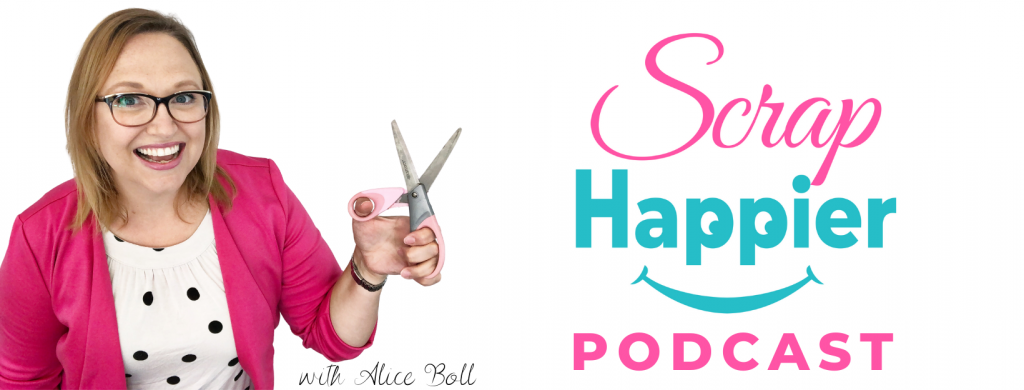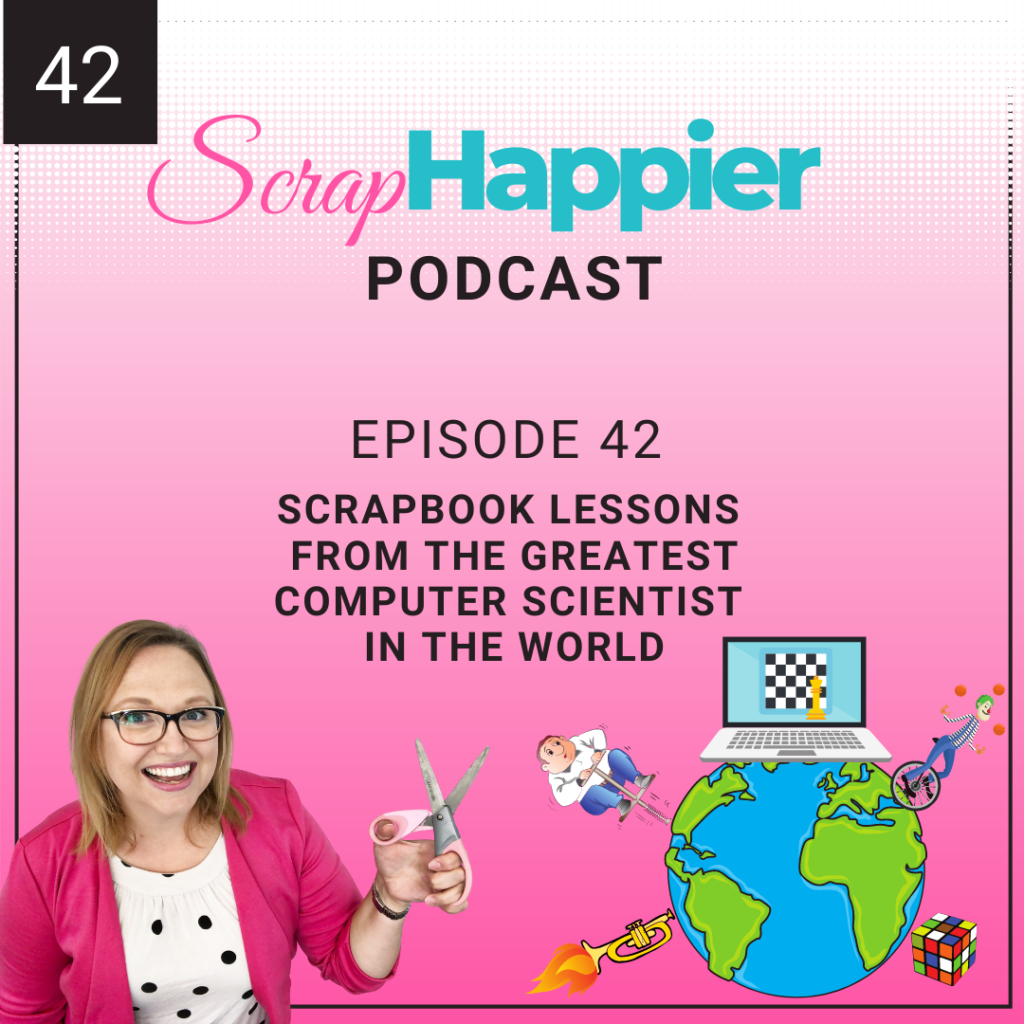
What other hobbies or crafts inspire you?
Tell Alice about it! Click the Start Recording button and leave a voice recording… it only takes a moment!
Connect:
CONNECT WITH ALICE
I’d love to hear your thoughts on this episode!
Sharing it? Use the #scraphappierpodcast on social media.
Instagram: @scraphappier
Facebook: ScrapHappy
YouTube: ScrapHappy
Alice’s Favourite products: FAVES
Sign up for Alice’s emails HERE.

Transcript:
Welcome to the ScrapHappier Podcast, where we share quick tips, tricks, and techniques to help you create scrapbooks you love and be happier while doing it. I’m your host, Alice Boll.
I’m so glad that you’ve joined me for this episode. We have something a little different to talk about today. I was really inspired by a podcast I listened to recently, and, no, it’s not a scrapbooking podcast. It’s something completely different. It’s called Cautionary Tales with Tim Harford, and the episode was called Fritterin’ Away Genius.
Have you ever felt that you suffer from scrapbook distraction? Have you ever given yourself a hard time because you’ve walked away from an unfinished page and it just ended up on a pile of other unfinished projects? Then I think you’re going to want to listen carefully. Or perhaps you have this problem. You feel that your pages are too predictable. You seem to be doing the same thing over and over. Well, listen up, there’s something for you in this episode too.
In the episode of Cautionary Tales, Tim Harford tells the story of Claude Shannon. You know the way that physicists talk about Einstein? Well, other computer scientists talk about Claude Shannon in the same way. In fact, he’s considered the greatest computer scientist in the world. Claude Shannon had two lightning bolt discoveries. When he was 21 years old in 1938, he devised the theory of a logic machine, that machines could perform any operation and solve any logic problem as long as you had a true or false statement, and you could use switches that were either open or closed, on or off. This is actually the discovery that led to the age of the digital computer. Thank you, Claude Shannon.
In 1948 when he was working at Bell Labs was his next lightning bolt discovery. He devised the theory for transmitting information. He figured out how to compress data so that it would take up less space. And then he went and did the opposite. He devised a way to add redundancy and extra data into information so that data could be transmitted over distant lines, like transatlantic cables, and actually have less noise and interference. He created files that had redundant data so that even if part of the data was missing, the rest of it could be devised.
So at this point you might be thinking, okay, this guy’s a genius. What did he do next? He spent time becoming a chess master, and he would play chess and other hex games, which are a type of board game. Then he would cycle his unicycle up and down the hallways at Bell Labs. Then he took up juggling and riding the unicycle and juggling and hopping on a pogo stick. He played with erector sets and made a robot mouse that could solve a maze. He made an early version of a chess-playing computer. He tried to figure out how to juggle upside down. He created flame-throwing trumpets. Yeah, let’s just let that sink in for a second.
He made giant styrofoam shoes to walk on water. He learned to walk on a tightrope. And here’s one that your kids, grandkids, and probably your husbands will admire, I know mine does. He created the ultimate machine where you flick a switch and a little finger pops out of the box and turns the switch off again. Let’s just say that hours of entertainment at our house can all be attributed back to Claude Shannon.
Claude’s boss understood the value of the work that he had already completed, and he said that Claude had earned the right to be nonproductive. And one time Claude had promised Scientific American, a very prestigious science journal, an article on the physics of juggling. He later wrote them a letter to say that they probably thought he was frittering away his time, but he’d actually come to a realization that he was a very good poet and that Scientific American should actually have a poetry section because he is really good at writing poetry and he had written them a poem about Rubik’s cubes.
So by now you might be wondering, Alice, what does this have to do with scrapbooking? Don’t worry. We’re there. So much of the advice we receive nowadays focuses on sticking to one task, to really diving head first into one topic, going all in and becoming really good, really proficient at that task. We hear about it in all kinds of places. Another podcaster that I follow is named Malcolm Gladwell and he talked about the 10,000- hour rule and how 10,000 hours is what you need to put in to become really expert at something.
But does that theory hold up? Claude Shannon said no. In fact, he reached out to Vannevar Bush. He was the person that headed the U.S. Office of Scientific Research and Development during World War II. And Claude Shannon told him that he was actually more productive and better because he worked on multiple projects. Vannevar Bush said that great scientists should range widely and keep changing things up. He advocated for breadth over depth. And this theory of trying different things and changing focus was backed up through a lot of scientific research. Apparently, scientists like studying other scientists too.
So how can we use this knowledge when we want to apply it to our scrapbooking? How can we go for the breadth over the depth? First of all, if you’ve ever suffered from distraction and you’ve left one project undone and started a new one, maybe you’re a little bit more like Claude Shannon. Maybe one project has inspired you more, and so you left that other one to the side. Is that really a problem? Is the guilt warranted? Should we even feel bad about that at all? If we move from one project that we were bored of and did something that inspired us much more, isn’t that actually a lot better?
One thing I’ve noticed with my own scrapbooking is that when I try different things, I feel so much more energized when I come back to my scrapbooking. For Christmas of 2019, I made my son a T-shirt quilt. And let’s just say, I am not a quilter. I am not a sewer. In fact, I am known for my reluctance to sew on scrapbook pages. But I’ll tell you that after I made that quilt, I actually sewed on scrapbook pages. I tried something totally new because I did something totally new.
The same kind of thing works whenever we try different kinds of crafts or other projects that get us out of our space, out of our own head, and out of our own constraints that we put on ourselves in our scrapbooks. So go ahead and spend some time sewing, quilting, crocheting, knitting, painting, doing watercolor, trying your hand at macrame, or maybe you just need a whole new experience where you’re out in the garden or raising some chickens.
Shifting gears and trying something new doesn’t mean that that’s going to be bad for your scrapbooking. Your current productivity might go down in scrapbooking because you’re engaging your time somewhere else, but when you come back to scrapbooking you’re going to be inspired. Maybe plant life is going to become something that comes onto your pages. Maybe you’re going to find yourself putting chicken feathers on a page, who knows? Okay. I’ll confess. I know because it’s exactly what happened during the summer of 2020.
And it doesn’t just have to be different kinds of hobbies and crafts. You can try different techniques. Maybe you’ll be inspired by making a monochromatic layout, playing with watercolor backgrounds, using photo-realistic paper, printing really large photos, making grid layouts, tearing paper, making lots and lots of layers, doing some digital scrapbooking, maybe using black-and-white photos, or diving head first into all the fun that mixed media can be.
Try changing your style of scrapbooking for a while. If you’re always making 12 x 12 pages, try making double page spreads, try making a traveler’s notebook, try 8 1/2 x 11 or 6 x 8 or one of the cool sizes like 9 x 12. Create a special project just for pocket pages. Give memory planning a chance. Just by switching up our sizes and our styles of scrapbooking, it puts us into a different creative headspace.
If you’ve ever felt that your pages are way too predictable and that you’re just doing the same thing over and over again, let’s go back to the podcast for one more piece of advice. When Claude Shannon discovered how to compress information and make it smaller so it would fit in a smaller size, that really applies to our digital life. But do you know how they do this? When they’re compressing a movie, they’re not actually compressing every single scene of the movie. They’re only recording the differences. By just tracking the changes and the differences, it allows them to make the file so much smaller because it’s really only the differences that are important.
And that works with our life too. When we go on a vacation, we remember that so vividly because it’s different than the rest of our days. And that means it will also apply to our scrapbooking. It’s the differences that will be memorable. When you try something new, it will be fun and exciting. It might not always work out, but that’s okay. It’s just paper. Most scrapbookers I know are not short on paper and supplies, and we can reprint that photo in just a few seconds. So by trying something new on your next scrapbook page, your pages will not be predictable. You’ll remember it because of the differences.
If you thought the story about Claude Shannon was interesting, I really encourage you to go and listen to the Cautionary Tales episode with Tim Harford called Fritterin’ Away Genius. Look at the famous scientists that we all know, Benjamin Franklin, Albert Einstein. They did not just study one thing. They’re actually not even just famous for one thing. They’re famous for multiple things in different disciplines. And we can do the same with our scrapbooking.
I hope that the inspiration from this episode encourages you to try something different, to dive headfirst into another form of creativity, whether it’s a different craft or a different technique or a different size or your style, and that it helps you to make layouts that you love.
You’ll find a link to the show notes underneath this episode. ScrapHappy will be hosting some fun activities in the near future, and I encourage you to get onto our mailing list. You can go to scraphappy.org/subscribe to get our Friday Five emails with all of the updates. It’s a little bit of ScrapHappy sunshine in your email box every Friday, or almost every Friday. Happy scrapping.
Fritterin’, fritterin’, frittering, fritterin’. Fritterin’ Away Genius.
